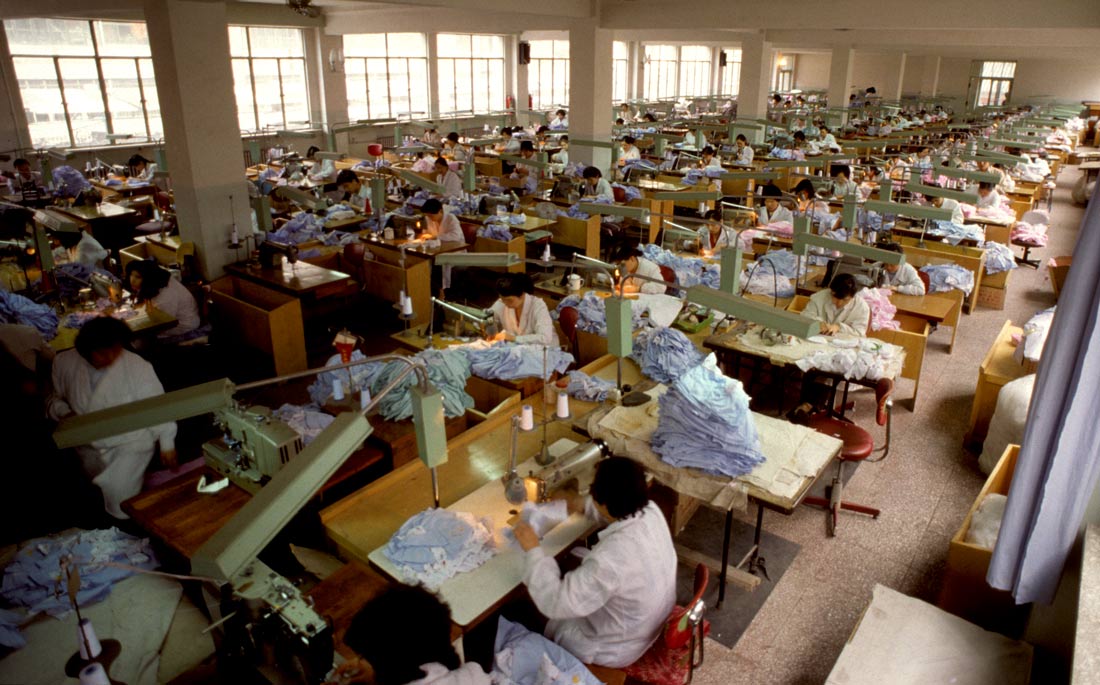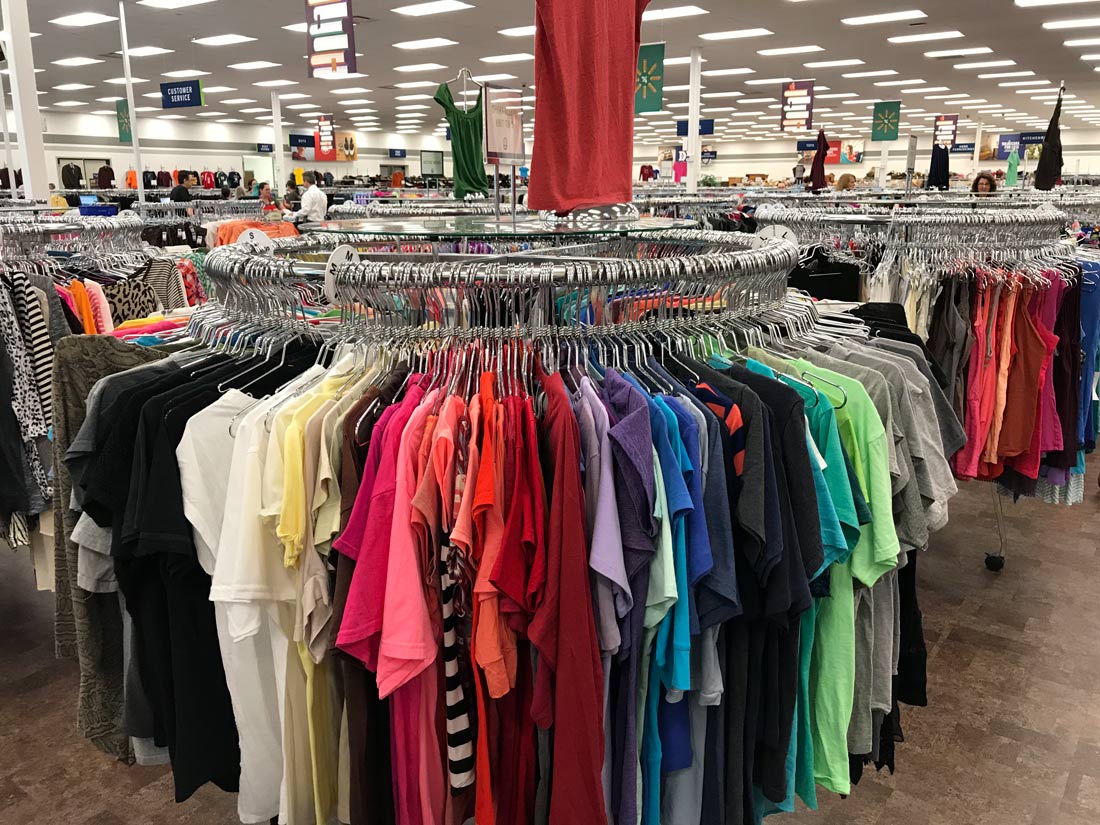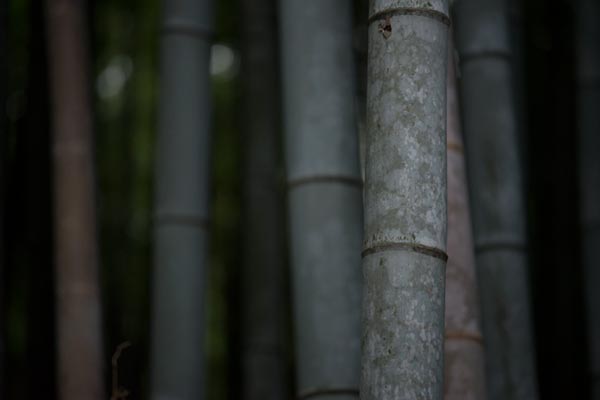Sustainable Clothing
Photos by Forrest Anderson
The trade war with China. Environment degradation. Household debt. To bring all of them into focus, we can all look in our own closets.
Here are some scary statistics to start off with:
American household debt rose to a record high of $13.5 trillion in 2018, seven percent higher than ten years earlier. Credit card debt also is at its highest point ever. A third of consumers polled say spending on clothing and entertainment most contributes to their credit card debt.
Global clothing production doubled between 2000 and 2017 to surpass 100 billion items annually in 2014, equal to 14 new items for every person on the planet. The average American consumer spends about $1,700 yearly on clothing. The carbon footprint of the apparel industry is an estimated 1.2 billion metric tons a year, not including widespread water contamination, a waste crisis caused by an oversupply of clothes, labor abuses in many textile factories, and microfibers from plastic-based fabrics permeating oceans and water supplies.
The average person buys 60 percent more items of clothing annually and keeps them for about half as long as 15 years ago, generating a huge amount of waste. Annually, $500 billion in value is lost to clothing that is barely worn and rarely recycled. The average lifetime of a piece of clothing is approximately 3 years but if that was extended by just three months, it would reduce their carbon and water footprints, as well as waste generation, by five to 10 percent. Nine months, and it could be a 20-30 percent reduction. Clothing is the fastest growing component in the household waste system.
How did we get into this mess? Forty years ago, clothing in the United States was much scarcer, high quality and expensive. Most of it was made by the U.S. textile industry, one of the country's major industries and one with a sometimes checkered history. Most of it centered around cotton, which until the Civil War was supplied by Southern plantations that used slave labor, and afterward was sometimes associated with sweatshops. Many people also made some of their own clothing or altered and repaired their clothes to extend its life for years.
China also has a long history of manufacturing textiles, with the advantages of low-cost, highly skilled labor. In the 1980s and 1990s, when Communist China opened to the outside world after 30 years of isolation from the West, the United States was flooded with low-cost clothing imports from China. This dramatically lowered the cost of clothing for the American middle and lower classes, and Americans eagerly bought. China developed a highly efficient supply chain that enabled it to keep costs low.

Above and below, Chinese clothing manufacturing in the 1990s. The sheer volume of goods produced in these factories was staggering and has only grown since.

The fashion boom coincided with a retail revolution in the United States as Walmart, Target and other similar retail chains interfaced with Chinese factories to provide American consumers with less expensive fashion choices than they had ever had. These companies contracted out production to China, focusing on design, marketing and logistics. China built some of the world’s largest textile factories and state-of-the-art ports and shipping facilities to meet the demand. In these global supply chains, retailers and branders established the terms and reaped the lion’s share of benefits while factory workers were paid low wages. Fierce global competition as more brands joined the fray meant that other developing countries such as Honduras and Bangladesh also exported large amounts of clothing to the United States as well as globally. However, China is the world’s largest exporter of clothing with 43 percent of the world’s total, far exceeding the amount any other country exports.
By 2018, the U.S. trade deficit with China was $419 billion, with apparel one of the largest categories of imports. U.S. manufacturing as measured by number of jobs concurrently declined 34 percent between 1998 and 2010 as U.S. companies outsourced manufacturing to China, including textile jobs, to reduce labor costs.
The textile industry is the world’s third most polluting, affecting the environment at every stage of production and consumption. Here’s how fashion affects the environment all along the lifecycle of a garment.
Raw Materials
Much of the trend in sustainable clothing marketed by fashion brands has focused on decreasing the environmental impact of agro-chemicals in producing raw materials. Cotton and polyester, often blended, make up more than 90 percent of all textile fibers. Cotton is the main material in more than 50 percent of all clothing produced worldwide. It is one of the most chemical-intensive crops. U.S. cotton production uses 25 percent of all pesticides used in the United States and more than 10 percent of the world’s pesticides. For every pound of cotton harvested, a farmer uses 1/3 pound of chemical synthetic fertilizer. Some companies produce genetically modified cotton plants supposedly more resistant to pest infestation, but they are controversial. Cotton hulls also contain potent insecticide residues that spread to consumers when used as cattle feed. Organic cotton is less than 1 percent of cotton production. It has reduced yields in comparison to conventional cotton and the weeding is more labor intensive. More environmentally friendly fibers also are used but are less popular. Soy fabric is less durable than cotton, but is biodegradable; hemp requires little water to grow, is resistant to most pests and disease and is durable and stronger than cotton; bamboo doesn’t need pesticides and agro-chemicals. A variety of other fibers have been developed, using banana plants, coffee beans and pineapple leaves, which have varying degrees of environmental impact.
Manufacturing
At least 8,000 chemicals are used to turn raw materials into textiles. The Chinese textile industry produces 10 percent of China’s total industrial wastewater discharge, the country’s third largest source of wastewater. Textile mills contribute about one-fifth to the world’s industrial water pollution. According to the Chinese Textile Industry Association, 25 percent of global chemical output is used in the textile industry, 42 percent of that usage in China. Some of these chemicals are carcinogenic or harmful to human reproduction. Manufacturers change naturally tan-colored cotton white by adding bleach, other chemicals and heavy metal dyes. Formaldehyde is added to make easy care cotton fabric. Bamboo requires a highly toxic bleaching process similar to rayon, and chemicals to soften it. An alternative method is scCO2 dying (supercritical carbon dioxide), which creates no waste by using 100 percent of the dyes. Reducing toxic chemicals requires fashion companies to identify, find and source substitutes for them as well as training suppliers, which is challenging because the fashion supply chain operates on multiple levels. Some companies have committed to replace toxic chemicals within a decade, but online shopping and e-commerce includes small firms that haven’t, so the bulk of the supply chain lacks strict chemicals management. Many Chinese textile factories have for years dumped toxic chemicals directly into waterways untreated, causing health problems for nearby residents. The result of this and other sources of industrial pollution is that most of China’s rivers are polluted, some to the point that the water is too toxic to touch.
There also are major concerns about low salaries and poor working conditions in many textile factories as well as fabric and yarn waste involved in manufacturing textiles. Attempts to produce 3D seamlessly knit garments using 3D software have been made to reduce waste. There also has been some work with zero-waste pattern making so that when a fabric is cut, the pattern pieces fit together like a puzzle piece to use all of the fabric.
Packaging, marketing materials, transportation and retail
Many brands sell themselves as sustainable and have made efforts, but lack systems to deal with oversupplies, the environmental impact of packaging and marketing materials, recycling fibers, repair services or other sustainable strategies. Most focus on textiles used. Critics have labeled some marketing as “green washing,” advertising sustainability while continuing to participate in business models that degrade the environment by selling too many clothes. A 2017 industry report projected that overall apparel consumption would rise by 63%, from the 2017 level of 62 million tons to 102 million tons in 2030, overwhelming and erasing environmental gains.
Laundering
In addition to the energy used to clean a garment over its lifetime, there is an increasing concern that microfibers shedding from synthetic fabrics are polluting water through laundering. Too small to be captured in waste water treatment plants filtration systems, they enter water systems and contaminate the food chain. One study found that 34% of microplastics found in oceans come from the clothing industry.
Discarding of clothing
More than 80 percent of discarded clothing goes in landfills, of which clothing makes up 10 percent and is growing. Clothing made of natural fibers or semi-synthetic fibers from plant-based cellulose such as rayon and Tencel produce the greenhouse gas methane as they degrade. However, they can’t be composted like food. Toxic bleaches, dyes, printing and other chemical baths that went into clothing manufacture can leach from landfills into groundwater. Burning them in incinerators releases these chemicals into the air. Because synthetic fibers such as polyester, nylon and acrylic are plastic, they take hundreds of years to biodegrade. The manufacture of polyester textiles went up from 5.8 million tons in 1980 to 100 million in 2015. The problem is an environmental crisis as the volume of tossed clothing in the United States has doubled in 20 years to 14 million tons, or 80 pounds per person, annually.
New York City spends $20.6 million annually to send textiles to landfills and incinerators. The city’s clothes recycling program has diverted 6.4 million pounds of textiles from landfills, but that is only .3 percent of the 200,000 tons of textiles that go to landfills annually from the city. Most charities that collect clothing sell just 20 percent of what they receive. Deseret Industries in Utah, which runs a chain of used clothing and goods stores partly to recycle goods and partly to train people for jobs in the retail industry, says they sell just 15 percent of the clothing donated to them. There simply aren’t enough people who need clothing on the scale at which it is being produced.
A major reason is the emergence of fast fashion as a marketing technique and business model in the fashion industry. Fast fashion arose as part of American retailers’ partnership with Chinese factories that are extremely efficient and flexible at producing and shipping on-trend clothing quickly. Fast fashion is inexpensive clothing produced rapidly in response to the latest trends on the catwalks or worn by celebrities. You too can dress today like your favorite celebrity did yesterday. Just get on-line, order what they wore or a cheap knockoff, and it is delivered to your door within a few days. This has been institutionalized by fast fashion chains with rewards, credit card systems and frequent e-mails with new offerings. Some fast fashion stores are now restocking with new designs twice a week rather than once or twice a season and placing clothing on sale in a dizzying blur so clothing is moving through the retail system faster and faster, with more of it being sold. The lightning speed at which these chains respond to and shape fashion trends has created a huge group of consumers who are interested in dressing in trendy clothing for a short duration, then chucking the clothing quickly and going on to the next trend. It is disposable clothing. Fifty percent of fast fashion items are disposed of within a year.
The discarded clothing floods into landfills or charity thrift stores, throwing the global market for recycling clothing and textiles out of balance. Fast fashion is ill-suited to selling in secondhand clothing stores that are their typical next stop after you have tossed them out of your closet. The reason is that patrons of second hand stores typically are careful bargain hunters looking for good deals in high-quality clothing that is classic, versatile, comfortable, and long-lasting. The last clothes they want are yesterday’s trends, executed cheaply and poorly. Herein lies a key reason that second-hand clothing stores sell a minority of the clothes donated to them. Fast fashion may sell at Zara or H&M, but it will be on the reject rack a year later at a secondhand store.
The market for recycling, donating and reselling of secondhand clothing has become glutted by fast fashion. Meghan Markle, duchess of Sussex, eluded to this problem when she commented on a rack of 40 or 50 lilac blazers that had been donated to the Smart Works charity of which she is a royal patron. This is an example of fast fashion that probably was created as the color lilac went into style and then out. By the time the blazers got to a charity store, they had become a non-versatile peripheral item that no one needs in a classic, timeless wardrobe. Unless your child is getting married and the wedding theme incorporates lilac, why would you need one?

Secondhand retail stores such as this Deseret Industries store in Utah have become superstores whose offerings are as high quality or better than those of some retail stores, but at much cheaper prices, as the clothing market has become glutted. Even so, they sell just 15 percent of their offerings.
By the time fast fashion garments have landed at secondhand stores, they are clutter that because of the increasing volume is more costly for the staff to go through to find good pieces that customers will buy.
Hundreds of thousands of pounds of clothing that don’t sell at secondhand stores are shipped to more than 100 developing countries daily. More than 70 percent of the world’s population wears used clothing, a great deal of which comes from the United States. Small wonder that U.S.-inspired clothing is the world’s overriding fashion trend. Huge warehouses process this clothing, with workers at conveyor belts mining clothing for valuable pieces to resell at vintage stores. Most of the rest is sorted into broad categories, then divided again by quality and material. Clothes are sent to different markets – Japan for vintage items, South America for mid-level clothes, Eastern Europe for warm clothes and African countries for lower-quality items. Secondhand clothing came to dominate the African market in the 1980s, contributing to sectors of the African textile industry tanking. However, traditional markets in Africa have started to reject fast fashion, and some leaders in the region have proposed a ban on importing secondhand clothing which they think fosters a post-colonial dependency on secondhand American goods. Others respond that used clothing creates jobs in selling, cleaning, repairing and tailoring and competition between secondhand clothing and Africa’s textile industry is not direct. Traditionally, Africans bought secondhand American clothing because they saw it as high quality and a good value, but it has come to be seen increasingly as cheap Asian-made goods that touched down briefly in the United States before arriving in Africa.
Much secondhand clothing is sent to be made into wiping rags for auto shops and other industries and about 20 percent to be chopped into a product called “shoddy,” which is used for insulation, carpet padding or car floor mats. Fast-fashion garments are more likely to end up in this sector. These items also will end up in a landfill eventually. Ironically, the cheapest textiles end up costing the most – to the planet when they are manufactured from virgin materials, to the people creating them who are paid low wages to do so, and to those who recycle them.
Recycling to make new fabrics
Recycling of fabrics to make new fabrics is arguably one of the most potentially sustainable options as it would create a closed-loop manufacturing process, but it still would continue to support a production system with excessive waste. It has the advantage of recycling waste such as plastic bottles, which takes 30% less energy than using virgin polyesters. Recycled plant-based fibers such as cotton become shorter in the recycling process and must be blended with new material to be durable. The process of creating textiles is extremely complex and this type of technology is problematic because once a product is dyed or blended with other materials, it can’t be broken down again into its pure form. Some manufacturers have released lines that have a percentage of recycled cotton, but that can result in a lower-quality textile that tears more easily. Some fashion companies such as H&M have provided funding to research these problems and technology to identify and sort garments made of different fabrics. This type of technology could help create a profitable market for old textiles. The U.S. textile recycling industry removes about 2.5 billion pounds of post-consumer textiles each year from landfills and creates more than 17,000 jobs. There are more than 500 garment-recycling companies in the U.S, most owned by small and family businesses. Textile recycling as an industry has great potential for expansion.
During the 2008 financial crisis, China bailed out the United States by buying U.S. treasuries to help shore up our economy and thus the world’s. China’s then-president, Hu Jintao, lectured the United States, saying it needed to cut down its consumption. We should take his advice. The massive U.S. trade deficit and Chinese trade surplus are symptoms of an unsustainable co-dependency between the United States that has caused environmental problems in both countries, made both Chinese factories and our retail sector far too dependent on American over-consumption, and contributed to serious and rising indebtedness in both countries. No one is arguing that we should go back to the way fashion was before imported Chinese textiles were available to the American consumer, but we are way overdue in reining in the excesses.
As the U.S.-China trade war has escalated, as many as a third of the textile factories in some Chinese towns have tanked. Some large garment factories have gone bankrupt. At the same time, Chinese domestic consumption has dropped. This level of dependence on producing products that are already way over capacity globally is unhealthy and Chinese leaders and economists recognize it. Many of the textiles are produced by low-paid workers who have flooded into China’s coastal areas, straining not just the coastal environment but cities’ social services.
The solutions are complex and will take years to work out. At the current time, all clothing manufacturing is to some extent damaging to the environment and some of it devastatingly so, so a key place to start is by doing less of it. This means that we need to curb our consumption of new clothing that goes out of style quickly. To this we need to add recycling and technological innovations to make the manufacturing process less polluting.
Many doubt whether an industry in which economic growth and profit is the main objective can deliver the agenda needed to reduce pollution and labor exploitation from which the industry profits. The fashion industry thrives on constant change and replacement of goods. Sustainability, on the other hand, thrives on continuity and conservation of resources. Are fashion and sustainability oxymorons?
As long as fast conspicuous consumption of clothing was confined to the rich, the global impact was not a major problem. However, the speed of fast fashion now is common across the industry. As cheap, on-trend clothes have become available to poorer people, they have adopted consumption habits that in the mid-twentieth century were reserved for the rich. Poor people can update their wardrobes as often as the rich.
Slow fashion, on the other hand, emphasizes durable products and design concepts that are seasonless. For textile workers, slow fashion would mean higher wages. For consumers, it would mean that clothing was higher quality and designed and manufactured with greater care to last longer. This would mean less clothing and industrial waste.
The solutions need to challenge the passive mode of fashion in which consumers do not repair, update, swap and plan their wardrobes to enhance the lifespan of products. If enough of us start to do this more actively, we can force a change of course for the behemoth fashion industry. This probably is the only force that will affect a fundamental change. While many countries have varying trade deficits with China, the United States stands alone in the size of its deficit. We need to look to the example of countries that still live and dress well while controlling their consumption of inexpensive imported goods better than we do. Buying smarter and less is the key to reducing clothing waste.
Here are some things we can do as average consumers to help relieve the global glut of poor quality clothes while eliminating credit card debt and mitigating the U.S. trade deficit:
- Substitute fast fashion for slow fashion in our own wardrobes. Slow fashion advocates assemblying a smaller classic wardrobe that costs less and has a smaller manufacturing and environmental impact. Prominent advocates of the slow fashion movement, such as YouTube vlogger Audrey Coyne have lots of tips for being stylish while having a smaller environmental footprint. Audrey focuses on having a well-planned wardrobe of good quality items that are versatile and last for a long time. She has tips for acquiring secondhand items and topping them off with a few other essentials purchased on sale. For people who enjoy fashion and shopping for clothes, Audrey’s approach is a good alternative to just hitting the stores or ecommerce websites and buying too much. It also works well for the budget-conscious shopper.

The capsule wardrobe approach, in which a few classic items can be mixed and matched, is a foundation for sustainable clothing. Since I started dressing this way, I have spent almost nothing on my clothes and I am never at a loss as to what to wear. These 12 items can be mixed and matched to create more than 30 outfits. Some of these items are more than a decade old and I got a number of them free.
- Adopt good strategies for buying secondhand clothing. My favorite in my own area is an annual clothing swap held by my church. At a designated time annually, we all take clothes we don’t want to the church, lay them out on tables by size and anyone who wants to can take whatever they need. The event is open to the public as a community service. Several congregations join together in this effort, so that we always have a selection of clothes that is as good as or better than what we could find in most stores. I routinely get most of my clothing from this totally free source, to which I also contribute with clothing and my time, and so do many of my friends. It’s a win for everyone. If I need anything else, I top my wardrobe off by purchasing a few items at a good secondhand store near my home or on an on-line sale. I avoid going to malls or fast fashion stores entirely, as having gotten into a slow fashion lifestyle, I dislike the poor quality items at such stores.
- I have had friends turn up their noses at the idea of wearing secondhand clothing. People need a reality check about what so-called new clothing went through before they purchased it. I've toured many textile and clothing factories in China and, believe me, the glamor of the fashion industry is gone for me. These factories varied widely in cleanliness, with some being modern and spic-and-span and others grubby sweatshops where finished clothing was dumped in a pile on the floor. Both the fabric and clothing go through many people’s hands during manufacturing. Then it is heaped up in warehouses, washed in large washers, ironed and packaged by many people. Once it gets into the retail stores, store personnel iron it and hang it on racks. Some of it has been tried on by several other customers or worn and returned before you came along. There is nothing pristine about new clothing. Most of the clothing at our clothing swap is excellent quality, much of it better than I could otherwise afford, and I have taken home from it many brand-new items that still had tags on them. It is common for stores to donate new items to our clothing swap and to secondhand stores. Realistically, most clothing spends very little time being worn in comparison to the time it spends hanging in a closet anyway.

- Learn to do simple repairs and alterations to extend the life of your clothing. I have gotten clothes for free or a very low price because they had a tiny rip or ugly buttons. A three-minute fix on my sewing machine or swapping out buttons with ones I had on hand solved the problem. It’s generally unrealistic to do time-consuming alterations, but simple ones can transform a garment and give it a new life.
- Many people enjoy doing craft sewing. Why not turn this interest toward making simple clothing that can top off your wardrobe with something good quality and unique? Few people want to spend time on traditional high-end sewing skills such as tailoring, but every once in a while, it’s fun and a relaxing hobby to turn a nice piece of fabric into a simple shirt. I keep a few simple tried-and-true patterns for this purpose. This slower process has given me an appreciation of what it takes to make clothing and allows me to express fashion creativity without a frenzy of buying.
- Take care of your clothes by following the laundry instructions, removing stains when possible and mending small rips in seams or hems.
- When you do buy new clothes, try to buy from companies that have fewer and better products, use thoughtfully sourced materials and fair trade labor practices and sell timeless products. Look for fabrics such as organic cotton; hemp; Tencel, which is made from wood pulp with less-toxic chemicals in a closed-loop process; Piñatex made from pineapple leaf fiber; Econyl which regenerates synthetic waste such as industrial plastic, waste fabric, and fishing nets from the ocean into nylon yarn (especially for seldom-washed items like sneakers); and Qmonos, a synthetic biodegradable silk.
Check out these related items

Sustainable Tourism for Holidays
Packing for travel this holiday season should include a primer on how to be responsible, sustainable tourists. Here it is.

A Minimalist Tries Marie Kondo
A confirmed minimalist finds that Marie Kondo's tidying method helps her to refine an understanding of what brings joy.

Sustainable Bamboo
Eat it, build a home or furniture with it, use it in the kitchen, use it for plumbing, wear it, make fences or containers with it.

Reclaimed Wood Gets A New Life
Japanese carpenters say that wood gets a new life when it is made into a new form. See some new of these new lives.

Mantel from Reclaimed Wood
Making a fireplace mantel from a reclaimed log requires mounting it so the supporting wall will bear its weight.

